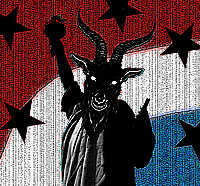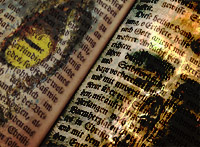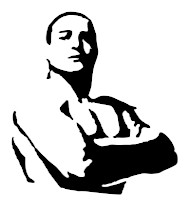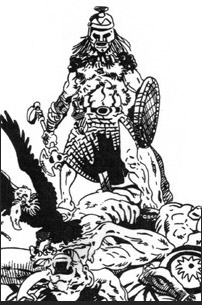Chapter 3: The Original Heavyweight Rivalry
Throughout the gloved era boxing has seen the rise of strong dominant heavyweight champions, who, upon getting old, are often "picked off" by a younger, faster fighter or a lighter and more technically oriented fighter. The classic examples were of Gene Tunney moving up from light-heavyweight and taking the title from Jack Dempsey and Ali knocking off Sonny Liston. More recently, the quintessential example was set by light heavyweight champion Michael Spinks who moved up to frustrate the aging Larry Holmes and take the heavyweight title.
What often happens in the case of light-heavies that move up to unseat the heavyweight champ is that the lighter man soon retires [like Spinks and Tunney] so that he doesn't have to face the array of monstrous heavyweight challengers. The example that points to the why behind this rather astute management decision was set by James J. Corbett and Robert Fitzsimmons; and the men who handle the light-heavyweight champions have never forgotten the example.
On September 7th 1892 in New Orleans the younger lighter Corbett administered a dreadful beating to aging John L. Sullivan to lift the heavyweight title from the first modern sports superstar. Corbett defended his title against a middleweight [which was common at the time] while avoiding the challenges of Middleweight Champion Fitzsimmons. Eventually the two fought and Fitz knocked out Corbett becoming the lightest heavyweight champion ever.
In those days the heavyweight champion made most of his money from endorsements and entertainment contracts and tried not to risk his title too often. Eventually Fitzsimmons fought James J. Jeffries [Corbett's old sparring partner] broke both of his hands on the big monster, and lost the title, going the way of most light-heavies who try to stick around in the heavyweight division.
This turn of events permitted Corbett to engage in his two best efforts, though they were losing ones. Although, Fitz, the quirky bare-knuckle veteran, had frustrated him, Corbett's move and jab style [he was the Ali of his day] was perfect for dealing with the massive Jeffries who seemed indestructible. In the first fight Corbett beat Jeffries for 22 rounds [and would have been awarded a win by decision any time after 1920] and then got KO'd in the 23rd. In the return match he out boxed the big man until getting caught in the 10th.
Ever since these two famously good fights this type of matchup between the jab-and-move stylist and the aggressive pressure fighter has provided the model for the classic heavyweight fights, such as Baer versus Braddock, Louis versus Conn, Ali versus Frazier, Norton and Foreman, and Tyson versus Douglas.
Currently boxing lacks this dynamic in the heavyweight class and the sport is suffering as the giant Klitschko brothers jab their way to one victory after another against hopelessly outclassed or undersized opponents. It is no accident that Corbett and Jeffries are neck-and-neck for last place in this lineup of all time greats, since white heavyweights of their day had little economic incentive to fight often or even regularly. It is however, a fortunate accident that these two fighters, who set the tone for a century of heavyweight rivalries to come, ended up a bare 8 points apart on a scale with a 1,183 point spread.
|
James J. Corbett Ring Name: Gentleman Jim Lived from: 1866 to 1933 Active from: 1884 to 1903 Fought at: 178 to 190 lbs. TB = 19 WD = 4 KO = 7 WF = 0 D = 3 KO'd = 3 L = 0 LF = 1 ND = 0 NC = 1 Career effectiveness: 102 Career rank: 145 Bout effectiveness: 5.37 Bout rank: 8 Overall rank: 86 Scouting Report: Corbett is an excellent mover and ring general with a good jab. He will actually throw vertical fist jabs over your head diagonally just to cut off your punches. He tends to slap with his right, has trouble with his hands and lets his chin rise when he throws his right. He is strong and crafty in the clinch and likes to strike his opponent's ribs with his radial bone [pinky side of the forearm] and break noses with his ulna bone [thumb side of the forearm]. Jim is a trash-talker who absolutely will not lead unless he is the larger fighter. Don't let the gay looking thong-shorts fool you. He's a tough Irish-American fighter. Jim never lost a decision and was only stopped by genetic freaks. Biography: Jim Corbett was one of the smartest men ever to win the heavyweight title. Although he had a brief reign and often came off as a poor sport, he was heroic in the ring against the much larger Jeffries and parlayed his ring success into a successful career as an entertainer. Although he was often a brute during his career and remained a virulent racist through most of his life, and rarely lived up to his ring name, he did eventually, in his old age, become a real gentleman, finally tamed by the woman he had once abused. The guy was a bookkeeper who played pro baseball and fought a 60 round draw against the black fighter everybody else was afraid to step in the ring with. You could never take him lightly. Boxing Impact: Corbett taught the world that the heavyweight class could be threatened and even ruled through the skills employed by the lighter weights. He was not so much an innovator as an adapter. He used the skills taught to him by middleweight champions and contenders to master a class of fighters who had previously been thought immune to skill. Until Corbett came along the gulf in skill between the heavies and the lighter weights was appalling, permitting middleweights to regularly challenge top heavies. After retirement he authored an influential boxing manual and in later life went on to promote not-for-profit amateur boxing events. Corbett's greatest boxing lesson has unfortunately been lost to time. He knew that to survive as a mover against a big tough man that he would have to be able to work the clinch. He actually trained with wrestlers a half hour per day despite criticism by boxing purists. If fighting today I think he would be a welterweight MMA contender of the 'sprawl and brawl' persuasion. A self-promoter like Corbett would not waste his time on a dying sport like boxing. He would go to Danna White with a Hollywood agent in tow and creative marketing plan in hand that would include television sitcom cameos and movie deals. His brother would surely be selling Gentleman Jim shirts in the lobby and his after party would be at an upscale steak house, not at a night club. Social Impact: Corbett fought before Thomas Edison's new motion picture machine and became the winner of the very first pay-per-view fight. His career became the subject of a movie based on his autobiography The Roar of the Crowd, the first in a long line of movies depicting the careers of famous fighters. On the dark side he was one of the White Supremacists who talked Jeffries into coming out of retirement to fight the proudly black Johnson. He even worked the corner of his former opponent, devoting most of his energy to hurling racial slurs at Johnson, who took his anger—if any—out on Jeffries with quips like 'Package bein' delivered Misser Jim' as he held the back of the big man's head and slammed shovel hooks into his chin. Despite such low points he took his Gentleman Jim image so seriously that he eventually cultivated himself into the type of retired athlete that sports fans a century later still admire. Corbett was like so many fighters a contradiction. But his carefully cultivated public persona became the model for aspiring champions down to our day; the model of character that every promoter wants to push before the cameras. Further Reading: Gentleman Jim Corbett: The Truth Behind a Boxing Legend, Patrick Myler, Robson, 1998 |
James J. Jeffries Ring Name: The Boilermaker, The California Grizzly Lived from: 1875 to 1953 Active from: 1896 to 1910 Fought at: 206 to 227 lbs TB = 21 WD = 3 KO = 15 WF = 0 D = 2 KO'd = 1 L = 0 LF = 0 ND = 0 NC = 0 Career effectiveness: 110 Career rank: 144 Bout effectiveness: 5.24 Bout rank: 14 Overall rank: 93 Scouting Report: Jim is a tall big-boned man who sucks a hundred pounds to get down to his fight weight. He fights out of a crouch with an extended jab, guarding his chin with his left shoulder and right forearm; the original 'peek-a-boo' style developed for Jim by his trainer Middleweight Champion Tommy Ryan. He is impossible to KO. To stop him you have to wear him down like Johnson did. He is essentially a one-armed fighter on offense with only his power jab and left hook. You should not hook with this guy unless you are a southpaw. Orthodox fighters should move to their left and stick to straight punches. Biography: Jim was a clean cut rural American famous for his strength and constitution. He was said to have cured himself of pneumonia [which was often a death sentence before antibiotics] by drinking a case of whiskey. If he lived in the early 21st Century he would be a middleweight MMA fighter. He was a skilled wrestler and exceptional track & field athlete who had Olympic level high-jump and sprinting ability. He was physically the Shane Carwin of his day, if Carwin had the athleticism of Uriah Faber! At 6, 2" 220 it is hard to think of him as a big man today. But he would have been a relatively big heavyweight at anytime up to the 1970s. He walked around at 300 pounds. That's still big, even at the strip-mall buffet. If not for his ill-conceived and reluctant comeback after a six-year retirement to satisfy his public's racist sentiments in a bid to unseat Jack Johnson, Jim would be considered by most to have been the most dominant heavyweight in history. Until meeting Johnson he was undefeated. Jim was also a man of character who knew his own physical limitations. When sports writers suggested, after his humiliating loss to Johnson, that he would have beaten the black man in his prime, he stated that he couldn't have laid a glove on Johnson at his best. He is one of the few fighters never to lose a decision. Boxing Impact: Jeffries set the bar for heavyweight champions. Since his career the boxing public has expected a heavyweight champion that will take on all comers and dominate the center of the ring. Social Impact: Jeffries was one half of the most socially significant boxing match in history. When he lost to Jack Johnson in Reno Nevada on July 4th 1910 race riots ignited across the nation, with at least two people killed for every round he had lost. He also, by his refusal to denigrate his opponent and graceful manner in defeat, showed that an athlete of stature could afford to take a morale stance in times when politicians feared to do so. Further Reading: Nathaniel Fleischer wrote a book about Jeffries in the 1920s or 1930s. I have only read reference to and excerpts from it and don't even know the title. Most information on Jeffries in print is to be found in collective works such as this one. |











too many inaccuracies in this to count proper research has not been done .
My primary sources were The Boxing Register, 2nd edition, The 100 Greatest Boxers of All Time by Bert Randolph Sugar, and Gentleman Jim Corbett by Patrick Myler. There was some conflicting information in these sources, but not much. So I think any inaccuracies would probably be due to my questionable typing skills rather than my agreeing with the wrong source.
My opinions, I am sure, will be out of line with the opinions of many boxing historians. If you could point out any factual errors that I might have made [dates, results, records, etc.] I would very much appreciate it. My scouting report on Corbett comes from Myler's book, where there was much discussion about Corbett using what we would consider 'karate' techniques to save his hands.
Thanks Anton.